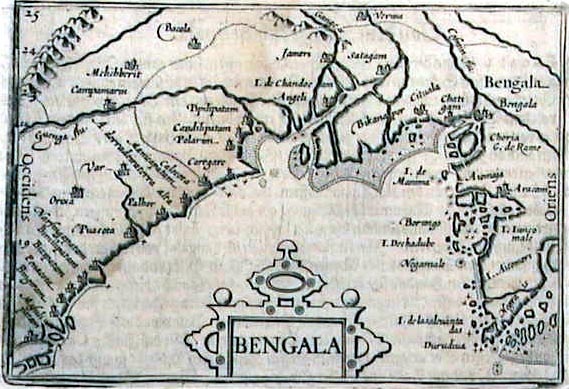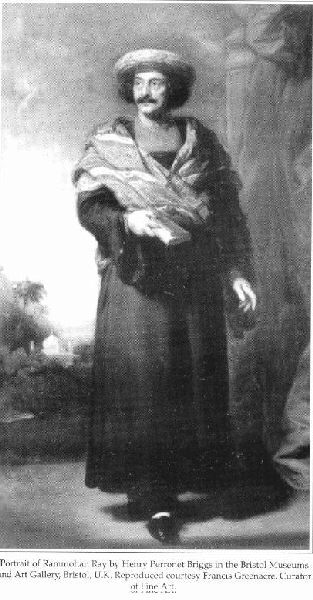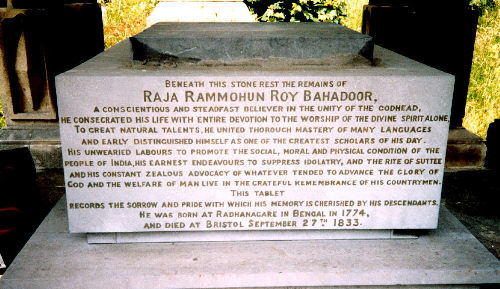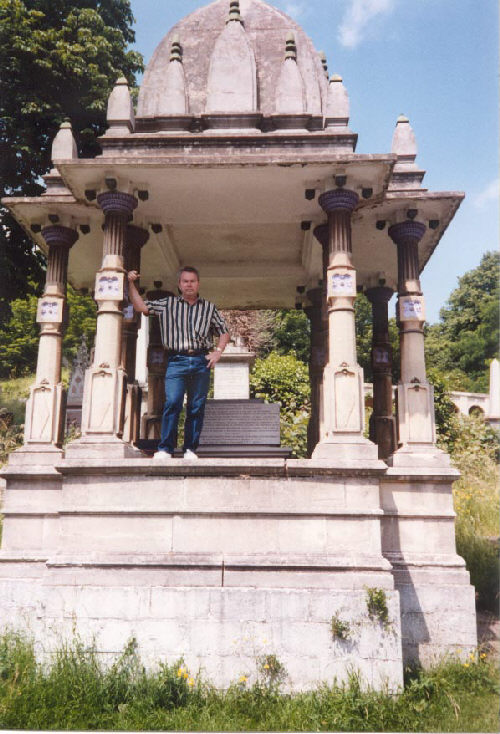The Life & Reforms of
Raja Ram Mohun Roy Bahadoor
[1772 - 1833]

Ram Mohun Roy, who is sometimes called the father of
modern India, founded a movement for a renaissance of
Hindu culture in 19th century Bengal. He challenged
traditional culture by organizing religious dissenters
and championing educational, social and political reforms.


His Early Life
He was born on May 22, 1772, in the village of
Radhanagar, Hoogley district, in British ruled Bengal.
His family, which was properous and of the Brahmin caste,
was in the service of a prominent landholder. His father,
Ram Kanta Roy, claimed descent from Narottama Thakur,
a follower of the 16th century Bengali Vaisnava
(sect of Visnu) reformer, Caitanya. His maternal forebears
were of Bhattacharyas of Chatra, chief priests of the
Sakta sect (mother goddess sect), with whom the Vaisnavas,
historically, had few dealings.
Little is known of his early life and education, but his
home life was marked by active religious conflict. He
seems to have developed unorthodox ideas at an early age.
After the death of his father, his mother unsuccessfully
attempted to disinherit him of the grounds of apostasy.

Setting Out On His Own
Alienated from his family, Ram Mohun supported himself by
moneylending, managing his small estates, and speculating
in British East India Company bonds. In 1805 he was
employed by John Digby, a lower company official.
Through Digby, he was introduced to Western culture and
literature. For the next ten years Ram Mohun drifted in
and out of British East India Company service as Digby's assistant.

 Natural Religion & Sanskrit Translations
Natural Religion & Sanskrit Translations
Ram Mohun continued his religious studies throughout this
period. In 1803 he had composed a tract denouncing
religious divisions and superstitions and advocating
"natural religion" in which reason guides to "... the Absolute
Originator who is the first principle of all religions."
By 1815 his spiritual roots were more clearly discernible,
when he composed a brief summary of the Vedanta Sutras
(an ancient Sanskrit religious treatise), in Bengali and
Hindi, entitled Vedantagrantha. In the same year he
published vernacular and English translations of his
abridgment of an unknown compendium of Vedanta doctrines,
the Vedantasara. There followed Bengali and Hindi
translations of the Kena and Isa Upanishads (1816), the
Katha and Mandukya Upanishads (1817), and the
Mundaka Upanishads (1819). The central theme of these texts,
for Ram Mohun, was the worship of the Supreme God,
beyond human knowledge, who supports the universe. These
publications established Ram Mohun, in the eyes of his
comtemporaries, both as a modern exponent of the Vedanta
school of Hindu philosphy and as a scriptural nonconformist.
He rejected the label of reformer. By translating the
sacred Sanskrit Upanishads into modern Bengali,
Ram Mohun violated a long standing tradition. In Appreciation
of these translations, however, the French Societe Asiatique,
in 1824, elected him to an honorary membership.
In 1815 Ram Mohun Roy founded the short lived Atmiya Sabha
(Friendly Society) to unite his growing following. These
activities attracted the attention of Baptist missionaries,
with whom be began work on a new Bengali translation of
the New Testament. This lasted long enough for a dispute
to arise over the divinity of Christ. For Ram Mohun the
issue was the same as with his Hindu critics: the unity of
the godhead. Yet he published in 1820, the ethical teachings
of Christ, excerpted from the four Gospels, under the title,
"Precepts of Jesus, the Guide to Peace and Happiness." A
vigorous debate with the missionaries followed, centering
upon the authority of the Bible and the doctrine of the
Trinity. Ram Mohun closely argued the Unitarian
anit-trinitarian position, publicly challenging
christian spiritual supremacy.

From Religious to Political Activist
In 1823, when the British imposed censorship upon the
Calcutta press, Ram Mohun, as founder and editor of two
weekly newspapers, organized a protest, arguing in the
spirit of the American and French Revolutions, in favor of
freedom of speech and religion as natural rights. This
protest marked a turning point in Ram Mohun's life, away
from preoccupation with religious polemic toward social
and political action. In 1822 he founded the Anglo-Hindu
School and four years later, the Vedanta College. When
the Bengal government proposed a more traditional
Sanskrit college in 1823, Ram Mohun protested that
classical Indian literature would not prepare the youth of
Bengal for the demands of modern life. He proposed, instead,
a modern, Western curriculum of study. Ram Mohun,
furthermore, led a protest against the outmoded British
legal and revenue administration, advocating the
separation of the legal and revenue functions, and the
adoption of the pancayat system, the Indian jury-trial system.
Ram Mohun's opposition to sati (ritual death of widows
upon the funeral pyres of the husbands) placed him in the
center of the biggest public contraversy of his
generation. In 1818 he had issued his first pamphlet
denoucing the rite from sacred literature. He followed in
1820 with another, arguing from Hindu law. Two years later
he published "Brief Remarks Regarding Modern Encroachments
on the Ancient Rights of Females According to the Hindu
Law of Inheritance." His newspaper Sambad Kaumudi joined
in the already growing outcry against sati.
Ram Mohun's actual influence on the passage of the 1829
act prohibiting sati is not clear, though there were many
afterward who remarked upon his role in the debate.
it has been widely accepted that he had the effect of
emboldening the government to act decisively, though he
himself favoured caution in governmental interference
in public religious life.
In August 1828 he formed the Brahmo Samaj
(Society of Brahma). The deed of the first Samaj building
declared its purpose to be "... a place of public meeting
of all sorts and descriptions of people, without
distinction, as shall behave and conduct themselves in an
orderly, sober, religious and devout manner: for the
worship and adoration of the Eternal, Unsearchable
and Immutable Being, who is the Author and Presever of the
Universe...." The Brahmo Samaj was to play an important
part, later in the century, as a Hindu movement of reform.

Raja Ram Mohun Roy
In 1929 Ram Mohun Roy journeyed to England as the unofficial
representative of the titular King of Delhi, to petition
the East India Company for an increase in the royal pension.
The king granted him the title "Raja," though it was
unrecognized by the British. Ram Mohun's personal
objectives for the visit were to lobby for reforms in
Indian government and to support the abolition of sati.
He was received with adulation, especially by English
Unitarians and by King William IV. During the summer of
1833 he traveled to Paris, where he was received by
King Louis-Philippe. But his health had declined in
Europe, and on Spetember 27, 1833, he died in the care
of Unitarian friends at Bristol, England.
Historical Impact
Ram Mohun Roy's importance in modern Indian history rests
upon the fact that he revived interest in the ethical
principle of the Vedanta school as a counterpoise to the
western assault on Indian culture and contributed to the
popularization of the Bengali language, while at the same
time he was the first Indian to apply to the Indian
environment the fundamental social and political ideas from
the American and French Revolutions.

Our Descent from Ram Mohum Roy
Arthur E. Merton was born on May 16, 1834, near Bristol,
England, eight months after Ram Mohun passed away.
We do not know who his mother was; only that she was a Merton.
Arthur emigrated to America sometime before 1859.
There he married Josephine Evans of Pennsylvania, who
was one of the first lady doctors in America. They had
three children, all born in Ohio. They both taught at
Oberlin College in Ohio. In 1870 he married his student,
Louisa Annette Wolf. They had four children. Leona Merton,
their daughter (my great-grandmather) is said to remember well
sitting in the lap of Mark Twain when he came to visit
their home. Arthur Merton's pen name was
Alesha Sivartha. He settled down near Bayard, Kansas,
where he died on April 8, 1915.

Written in 1990 by
Don Ross. Unfortunately I did not write down my sources, but I do remember finding articles in two or three different
encyclopedias with information on the life of
Ram Mohun Roy, plus the research of my grandmother, Zaida Marie Ross.
Web page by


 Natural Religion & Sanskrit Translations
Natural Religion & Sanskrit Translations
